


new to teaching but old to the love of learning
As one of my projects to show evidence of my learning, I decided to make a PowerPoint summary of the final topic, sharing resources & practicing open learning. To create this learning reflection, I read the three readings given to us in our topic resources and compiled a set of keynotes I found most useful/intriguing throughout the three articles. In doing so, throughout these readings, I was able to critically reflect on the importance of open research and open data in an educational setting. I was also able to practice my digital literacy in using a program I am not comfortable with (Microsoft PowerPoint). In doing so, I can take the knowledge I learned from creating this presentation to and use this program to aid in my lessons and teaching resources in an open and online learning environment.
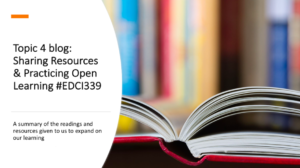
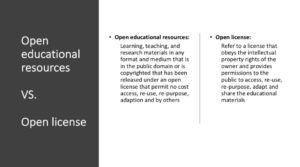

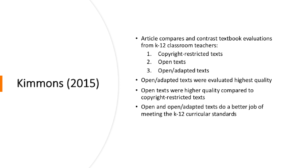
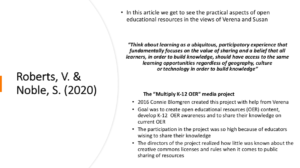
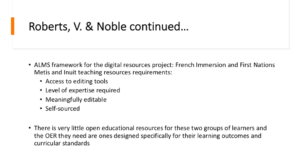
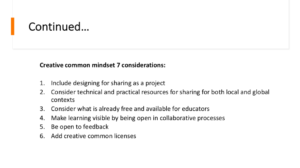
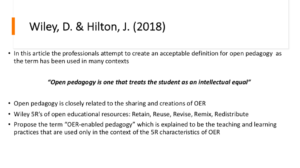
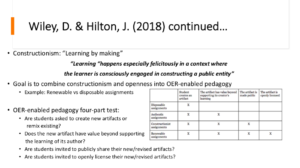
 For one of my portfolio projects, I decided to step out of my comfort zone and join in on the July 23rd Twitter live chat with my #EDCI339 family. How the chat worked was our professor Verena Roberts would introduce to the group every few minutes a new topic question, and it was up to us to answer, reply, comment, and share our knowledge and experience on the topic. To start,
For one of my portfolio projects, I decided to step out of my comfort zone and join in on the July 23rd Twitter live chat with my #EDCI339 family. How the chat worked was our professor Verena Roberts would introduce to the group every few minutes a new topic question, and it was up to us to answer, reply, comment, and share our knowledge and experience on the topic. To start,  I had to initially sign up for twitter as I didn’t have an account already. I found the signing up portion of the app simple and self-explanatory. The only difficulty I had with the entire process is figuring out the little tricks to using twitter. Like Facebook or Instagram, there are options to like people’s tweets and to reply to them. However, once you did reply to a tweet, the interesting part was that the reply didn’t show up attached to the original tweet but instead was a tweet in itself that had a link at the top back to the original tweeters tweet. The entire process of the live twitter chat I would say was more of a learning experience using twitter than one about the topics we were discussing. I ended up feeling very stressed throughout the hour just because of the high volume of replies and comments coming in, and I had feelings of overwhelmedness. Although I had these mixed feelings, in the end, the experience of the Twitter chat gave me more knowledge in the aspects of online and open learning. I was able to witness human-centered learning first hand through the diversity of knowledge being shared, I had the chance to practice my digital literacy by exploring a media app I have never tried before, and I can take this experience of mine and reflect on how I currently and in the future can use Twitter in my future classes and personal pedagogy.
I had to initially sign up for twitter as I didn’t have an account already. I found the signing up portion of the app simple and self-explanatory. The only difficulty I had with the entire process is figuring out the little tricks to using twitter. Like Facebook or Instagram, there are options to like people’s tweets and to reply to them. However, once you did reply to a tweet, the interesting part was that the reply didn’t show up attached to the original tweet but instead was a tweet in itself that had a link at the top back to the original tweeters tweet. The entire process of the live twitter chat I would say was more of a learning experience using twitter than one about the topics we were discussing. I ended up feeling very stressed throughout the hour just because of the high volume of replies and comments coming in, and I had feelings of overwhelmedness. Although I had these mixed feelings, in the end, the experience of the Twitter chat gave me more knowledge in the aspects of online and open learning. I was able to witness human-centered learning first hand through the diversity of knowledge being shared, I had the chance to practice my digital literacy by exploring a media app I have never tried before, and I can take this experience of mine and reflect on how I currently and in the future can use Twitter in my future classes and personal pedagogy.
Timm! Again, I am writing this for the third time, but I love how you gave a clear definition of the term equity before beginning your blog. I am starting to realize that I should have done this as well! Thank you for adding in the  “Cultivating Equity in the Classroom” video, I have always loved these simple draw-as -I-teach videos because it is the pure definition of multimodal. I cannot believe how skilled you have got in creating these beautiful informational images the graphics you chose were perfect and so pleasing to the eye. I can say that I agree that when I first began this course, I too thought that design principles and design theories would all be very different regardless of if the classes were face-to-face or online, but maybe they are not. There are specific characteristics in both scenarios that if were not made would create utter chaos and inequitable classroom, however, in the end, a teacher’s job is all the same to create a learning environment fit to each student’s individuals needs.
“Cultivating Equity in the Classroom” video, I have always loved these simple draw-as -I-teach videos because it is the pure definition of multimodal. I cannot believe how skilled you have got in creating these beautiful informational images the graphics you chose were perfect and so pleasing to the eye. I can say that I agree that when I first began this course, I too thought that design principles and design theories would all be very different regardless of if the classes were face-to-face or online, but maybe they are not. There are specific characteristics in both scenarios that if were not made would create utter chaos and inequitable classroom, however, in the end, a teacher’s job is all the same to create a learning environment fit to each student’s individuals needs.

Josh! What a brilliant idea actually giving an equity definition in the intro to your blog! It truly gives the reader a sense of where the blog is going and what we should be looking for in your writing. I can say with honestly how much I appreciate the graphic you chose to help your definition. This image has always been a concrete difference for me when comparing equity and equality (it is also a great image for students). I agree with your opinion wholeheartedly on how to create an equitable classroom and love how concisely you exampled your topic reading findings. I believe that it is important to the point you admitted about it is the teacher’s decision of how to create a learning environment, however, in the end, it should always come down to what is best for the students.

Leona! I love your version of the definition of equity in education. I think that it is important to note that there are differences when it comes to equity in various situations. I cannot say enough. how much you help us as readers hyperlinking all your resources! It is a perfect example of how we can use interactive and multimedia learning in all our classes. I love how you included the design principles as well from the Kral & Schwab reading. I found that reading to be easily the most insightful to me and truly opened my mind to the possibilities that can come from making learning spaces that provide equity for all learners. As per-usual great blog, and wonderful use of combining all the readings together to make one beautiful summary.
Topic three, “Equity and Access in K-12 Distributed (Online) & Open Learning Environments,” consisted of three different readings of all different modalities. The first: Basham, Blackorby, Stahl, & Zhang, L. (2018), is an academic article that explained the framework and reasoning behind the Universal Design for Learning (UDL).
“A scientifically valid framework for guiding educational practice that-(A) provides flexibility in the ways information is presented, in the ways, students respond or demonstrate knowledge and skills, and in the ways, students are engaged; and (B) reduces barriers in instruction, provides appropriate accommodations, supports, and challenges, and maintains high achievement expectations for all students, including students with disabilities and students who are limited English proficient.”
(Basham, Blackorby, Stahl, & Zhang, L., 2018)
In this article, we learned that UDL has been around in education for two decades and created originally, to provide equal and effective inclusion for students with disabilities or diverse learning needs (Basham, Blackorby, Stahl, & Zhang, L., 2018). UDL is now a model designed for all learners, however, it still has the same ideals of providing equity for all learners in their education. In the article, the authors give us a variety of terms from research studies that give way to the idea of creating equity in an online classroom:
The article also gives the reader some statistics around the  current population enrolled in online learning and how these numbers relate to the diversity of the learners enrolled:
current population enrolled in online learning and how these numbers relate to the diversity of the learners enrolled:
2.2 million students take complemental online courses
White students make up 75% of the current online students
There is an expected increase in traditionally marginalized populations within online settings
Less than 25% of online students are Hispanic, 13% are Black, 2% or less are Asian, and 1% of online students are Native American
Students with disabilities make up 7.2% of online students
Students at or below the poverty level comprised 45% to 48% of online enrollment in contrast to making up 35% in face-to-face settings
“Clearly the practice of K-12 education, in general, and the growing presence of online learning needs to become more effective in supporting the strengths and addressing the weaknesses of the students for whom they are responsible.”
(Basham, Blackorby, Stahl, & Zhang, L., 2018)
The second reading by Kral, & Schwab (2012) is a more multimodal article that gives us a list of design principles that should be considered when building and facilitating a learning environment. These principles are a way for us to answer our blog guiding question as they work towards creating equity in the classroom and are created to provide equal opportunities for learners of all contexts. The real-life example the article gives us is of first nations in Australia where they put context to these principles.

Learning capacity:
“To think for yourself, decide for yourself, you have the power to change that whole scene with the edit. You gain the confidence to make those decisions, to stand strong in what you believe, and what you see and what you think is best for yourself and other people.”
(Kral, & Schwab, 2012)
“The best way to learn is to do it, get in there, get your hands dirty, get on there, play with it…”
(Kral, & Schwab, 2012)
“It is evident that where young people have access to digital resources and technologies, they are engaging in new forms of media production to express themselves and their cultures.”
(Kral, & Schwab, 2012)
Finally, the last reading, a blog post by Selwyn (2020), gives us clear insight into how learning design is now; based on the needs of students in the Covid-19 pandemic.
The impacts Covid-19 has had on our students and teachers (as stated in my blog) has also affected the variety of learning settings including online school.

“After young people being taught through google classroom and zoom lessons, it is reasoned – we’ll have to seriously consider the prospect of online education taking on a more prominent role as school systems adjusts to the post-pandemic world.”
(Selwyn, 2020)
It is shocking how fast the world of education changed in the matter of just days and how this changeover altered the views of online and distributed learning. As stated by the reading, what happened in months is not equivalent to the research on how impactable online learning can be. There was no thought to think of the “educational inequities” behind the choices that were made by teachers and students because there was simply no time. With a change from students coming to a face-to-face classroom now having to have access to the internet, technology, and time there was utter chaos and frustration from all parties. At this moment, teachers could truly understand the “not one size fits all” assumptions that come with education and learning design. There were issues of Digital flexibility, Timing flexibility, and overall Student participation. Covid-19 has shown teachers just how big of a deal it is to create a learning setting that is unique and customizable for each student and has shown us what happens if it isn’t.
References
Basham, J.D., Blackorby, J., Stahl, S. & Zhang, L. (2018) Universal Design for Learning Because Students are (the) Variable. In R. Ferdig & K. Kennedy (Eds.), Handbook of research on K-12 online and blended learning (pp. 477-507). Pittsburgh, PA: Carnegie Mellon University ETC Press.Masters, G. (2018, April 30)
Kral, I. & Schwab, R.G. (2012). Chapter 4: Design Principles for Indigenous Learning Spaces. Safe Learning Spaces. Youth, Literacy and New Media in Remote Indigenous Australia. ANU Press .http://doi.org/10.22459/LS.08.2012 Retrieved from: https://press.anu.edu.au/publications/learning-spaces %EF%BB%B
Selwyn. N. (2020). Online learning: Rethinking teachers’ ‘digital competence’ in light of COVID-19. [Weblog].
Of all the topics covered in this course, the one that made me critically reflect the most was topic three, Equity and Access in K-12 Distributed (Online) & Open Learning Environments.
Growing up in a household of two teachers as parents I wasn’t living the most privileged life, however, I never had the feeling of being left on my own, or inadequately able to complete my work. I had access to wifi, technology, and my parental support, all things that a large percentage of students do not. After reading topic three’s readings on what occurred when the pandemic hit and students, teachers, and parents were forced to move to an online school setting I couldn’t help but notice that the readings were missing a very clear perspective, one of the teachers and their feelings towards their student’s differing at-home situations. To find this missing angle, I decided what better way than to talk/interview my very own parents in their experience during the COVID-19 pandemic and hear about their own student’s challenges to access the online learning reality.
This opportunity allowed me to examine and reflect the various means of equitable access students had (and still have) when entering online and open learning contexts. It also shows how these inequalities don’t just negatively affect the student’s but emotionally affect their teachers as well.
Grade two teacher
Situation 1: Single mom supporting a family of three
“Of the kids who went online, I had 13-14 regulars who came on but I had this one little boy who’s family, single mother, did the best she could, she managed to buy each of the three boys a tablet that they could use as an online resource, but the tablet was probably an $80-$100 tablet, which is great but when the boys went online, they couldn’t use Zoom because the audio feature wasn’t compatible to the tablet, they couldn’t actually get on the online chat because the word processor on the tablet wasn’t quality, up-to-date program. The boys didn’t have great internet, so there would be constant glitching where at times you wouldn’t be able to even see the boys or the Zoom video would consistently log him out so I would be receiving messages throughout the meeting from his mom saying “we can’t get on.” What would happen is when we were sharing stories as a class and I knew he had a really good story that he wanted to share we wouldn’t want to ask him to share because we knew he was just going to glitch out, and it was just so sad. This is a family, one who actually tried really hard to participate, and it just wasn’t fair.”
Situation 2: Full family support and access to unlimited online learning tools and technology
“Another student I had, to show the other side of the inequality scale, was a student whose mom and dad were very tech-savvy. So this little boy ended up creating a youtube channel and videos that he would post, make his own script-writing, did his own editing, add music to the videos, and would send thee videos to me that I would post on our class website. He personalized his online learning and was technically was above any of us. It just shows you that it’s not fair. Not only did he have the equipment, the video camera, and the whole set up he could use, he had the parental support. His mom was home 24/7 and when his dad did come home from camps he would help the boy with all of the editing and stuff.”
Grade two/three teacher:
Situation 1: Divorced parents, a mother with mental health and addiction problems and a father who is functionally illiterate
“A boy in my class was living with his dad who is unfortunately almost illiterate and didn’t have any access to wifi or a computer/tablet since he spent most of his time working in camps, so I tried to get him access to one of the school’s resources. On the news, you hear about all these school districts giving away their iPads and resources to students in need thinking just how great the program is when really it is each specific school administrator’s choice whether to or not. So I managed to get in touch with our administrators who gave this boy a ten-year-old iPad that only had access to the school district wifi, so basically, if he wanted to use this iPad he had to be within twenty feet of any school. So that didn’t work. The only time he could get on to my website or our Zoom meetings was when he was with his grandparents, who as well had an computer that didn’t work. During the month of online learning, he got on once. I invited him to email, talked to his dad and his grandparents asking them to help him compose emails to me but he never did.”
Situation 2: Family that didn’t care for online learning
“I had a little girl who didn’t go online once, not because she didn’t have the opportunity or technology to but because the parent said she wasn’t going to participate in online learning. So is just shows that some parents who have the potential to allow their kids this opportunity and to let them virtually learn, just simply don’t want their children to be online.”
| Question: | Answers (In Note Form) |
| Describe your persona | See the profile below |
| Will this student be learning all online, blended, with support … Describe the “mediums” in which this persona might be learning. Where would the learning be asynchronous or synchronous? Why? | Blended – the child will be in class when he is able. But the reality is that he will be learning from home up to 3 days a week most days. Due to his home responsibilities, the learning will have to be asynchronous.Synchronous mediums: In-class learning, “roboting” into class using telepresence robot, web-broadcasted teacher instruction. Web-based apps
Asynchronous mediums: Web-based platform; e.g. google classroom, moodle, Microsoft OneNote, or others. Web-based apps –Google street view (Google Earth) – Gimkit – Floop – Nearpod – FlipGrid Take-home hand-outs and materials provided by the teacher (non-web-based) |
| List/ describe any digital tools that might be considered to support online learning. | Thomasz will be using a variety of digital tools that will help him succeed in his blended learning experience and his ability to cope with his general anxiety disorder and struggles with his attention span. The goal of his online learning experience is to “minimize threats” (UDL) while still having a sense of classroom belonging and community. The majority of his online learning will encompass more interactive learning (podcasts, videos, interactive readings, etc.) and learning with his close peers (who Thomasz feels comfortable working with). The digital tools that will help Thomasz in his learning journey include:
Teacher tools
|
| How would you describe this student’s ideal learning context? | Ideally, the child wants to feel that his at-home learning and in-school learning can be a seamless transition. He doesn’t want to feel like he is an outsider among his peers.He enjoys working through his schoolwork at home with his parents.
|
| What are the real and perceived barriers to learning that are preventing safe, flexible and supportive learning experiences and environments for this student? | Parental limits in the schedule (in supporting learning), anxiety and attention issues, limits in his personal schedule (taking care of siblings). The need to be intrinsically motivated. Possible internet connectivity issues (as is the reality with any online-based learning). Family responsibilities (siblings). |
| Are there real or perceived equity, social justice or cultural considerations that may be preventing safe, flexible and supportive learning experiences and environments for this persona? | We plan on creating a classroom where learners will always have space that is safe, welcoming, and supportive, free from any cultural bias or discrimination of any form. However, we will never shy away from discussing or acknowledging the way people feel that their personal identity may be affected by the society in which we live. Therefore, even though our student has no obvious need for considerations around this topic, we will always be aware that this issue may arise and we will confront it as needed. See our reference list for the multitude of articles we researched on ways to support ALL learners. |
| How would you design for this persona in a distributed learning medium versus an open learning medium? What are some of the differences that you would consider? (Check the EDCI339 Section A03 Project Description for more details about this question. The EDCI339 A)4 has a k-12 focus and is different from the EDCI339 A03 project. please follow the EDCI339 Project Expectations) | Distributed: include a mix of synchronous and asynchronous class meetings for activities and collaboration. Use online technological applications that can be used in real-time with the class and individually for formative assessment (eg Quizizz). Digital delivery of content through a learning management system using multiple modes of representation such as text, video and audio.In this online setting, we will also consider the eight design principles prescribed by Kral and Schwab (2020) when structuring our learning space. In particular, we will ensure that we create spaces for multi-modal self-expression and socialization with peers in our LMS to help bridge the gap between Thomasz’s online and face-to-face learning experiences
Open: integrate networked learning through the use of participatory culture, digital learning spaces and open educational resources to support the personal inquiry/connectivist learning approach. To assist Thomasz at home, structure learning assignments that require documentation (eg e-portfolio) over a period of time (formative assessment) that can be shared with others in the class and beyond. Heightened consideration of FIPPA and privacy policies are needed in open learning as information is shared beyond class walls. With greater flexibility, choice and capability for informal learning experiences, open learning would require increased teacher/parent support or self-efficacy skills in research, documentation and reflection. |
| How could your learning design support multiple means of engagement? Check http://udlguidelines.cast.org/ for more information. |
Minimize threats and distractions (7.1):With Thomasz’s diagnosed general anxiety disorder, it is important to create a safe environment for Thomasz. In Thomasz situation, this would include increasing small group work with who he feels comfortable with, creating a classroom community, and having constant communication with Thomasz to help him and help with his blended learning experience. Facilitate personal coping skills and strategies (9.2):For Thomasz to successfully manage in a classroom setting and find a way to decrease his anxiety, there needs to be a classroom and school plan. In Thomasz’s classroom, he has personal connections in the school to help scaffold strategies to develop internal controls and coping skills as well as tri-weekly one-on-one classes with the school counsellor. These gatherings are designed for emotional support and a review of daily checklists, reminders, and models. Foster collaboration and community (8.3):For all learners, to have the most positive learning environment, there is a need for respectful connections, positive relationships, and a helpful community. Our learning design supports the fostering of collaboration and community because there is lots of opportunities for Thomasz to communicate and collaborate with peers he feels comfortable around to create his own sense of community. This is where he feels safe and has lower anxiety. This goal for Thomasz (and the class) is done through collaboration, web-broadcasting when Thomasz is learning online, and constant opportunities for classroom community building (small groups if necessary to accommodate Thomasz). See; list of tools in our previous sections. |
| How could your learning design support multiple means of representation?Check http://udlguidelines.cast.org/ for more information. | Perception (provide information in different modalities and in a format that allows for adjustability by the user)
Language & Symbols (provide alternate representations for accessibility, clarity and comprehension)
Comprehension (scaffold information for knowledge construction, processing and transfer)
See; our list of tools to be used for this purpose in the sections above. |
| How could your learning design support multiple means of action and expression?Check http://udlguidelines.cast.org/ for more information. | Physical Action (interact with accessible materials and tools)
–In our learning designs, to give Thomasz his best chance to participate in all the class activities both face-to-face and virtually, we can vary the methods of response and navigation for Thomasz to eliminate any boundaries that virtually learning leads to (not having him physically present). –We will provide alternative means of how Thomasz can present his learning to us. Instead of the traditional print-out work packages, Thomasz will be able to (if he chooses) to optimize his advanced computer skills by using writing programs such as Microsoft Word and Google docs. Thomasz will receive all his homework packages, class material, and notes through online classroom websites such as Google classroom. This way, Thomasz will have the opportunity to stay up to date with his peers even at home.
-To minimize distraction and potential miscommunication across Thomasz blended learning platforms, Thomasz will (with the help of a mentor) complete a weekly task list with clearly stated “goals” to complete for the week. This task list will be made on a platform such as MyHomework, Wunderlist, or Boximize. This will also minimize the stress on Thomasz and assist him in managing his organizational stresses. -On these weekly task lists, Thomasz will make clear instructions on which platforms he should use for his lessons (both virtually and face-to-face). The goal behind the clear instructions of the weekly tasks is to relieve the possibility of inappropriately using the resources Thomasz is given to aid his education (computer, tablets, online apps/games). Expression & Communication (compose and share ideas using tools that help attain learning goals)
-Because of Thomasz unique blended learning situation, he will not at all times have access to the same forms of media platforms as his peers. To help Thomasz anxieties of feeling “socially distanced” from his peers in his learning design plan we will give Thomasz the opportunities to express himself through “normal” face to face interactions and virtual sharing platforms. Thomasz will be able to be “roboted” into his class through a moveable telepresence robot which will enable him to interact with his peers and the course material. -Thomasz will be able to complete his learning goals through a variety of social media and interactive web tools. Examples of web tools he would be using include: -His private personal learning blog where he will be able to track and show his learning -Google Classroom, where he and his classmates can engage in discussion forums -Zoom video webinars with his teacher where he can engage in one-on-one lessons and use tools such as “screen share” to exhibit his learning to his teacher
-To aid Thomasz in the quality of his work and to help alleviate added stress of time management, he will be offered the help of educational apps and tools: -Spellcheckers, grammar checkers and word prediction software (Practice English Grammar, Sentence Builder, Montessorian: intro to words) -Text-to-speech software, voice recognition software and screen/sound recording (Speechnotes, Screencast) Build fluencies with graduated levels of support for practice and performance (5.3) -To assist Thomasz through his learning, in our plans we will create multiple scaffolded lesson plans that can aid him in independence in his learning. These scaffolds will be evidenced in his weekly task lists. -Because of Thomasz’s blended learning situation, he will be working with many different teachers/mentors. He will be with his classroom teacher in school, a tutor/EA, and his teacher at home over webinars, and if available, his mom and dad. Having these multiple sources of guided learning figures will help motivate Thomasz by allowing him to see various approaches he can take in his learning. Each mentor/learning figure will be able to give Thomasz differentiated feedback that will all be directed to Thomasz’s unique learning needs.
Executive Functions (develop and act on plans to make the most out of learning) Guide appropriate goal-setting (6.1) -To help assist Thomasz in becoming an independent learner and to help him manage his anxiety with both organizational skills, we will implement a weekly task list that contains scaffolds and guides to maintaining consistency in his work ethic and schooling both at home and face-to-face. Along with these weekly tasks, Thomasz will sit down with his various mentors to create long-term and short-term goals based on Thomasz’s desires and learning outcomes, as well as his parents, his teacher, and provincial educational standards. Support planning and strategy development (6.2)/Facilitate managing information and resources (6.3)/Enhance capacity for monitoring progress (6.4) –To help Thomasz see his growth and to monitor his progress for his parent’s benefit and the school’s, his teachers/mentors will keep records of Thomasz’s progression of weekly expectations, monthly expectations, and yearly expectations on a scale designed by his mentors with help from Thomasz. We wish that Thomasz can feel comfortable sharing how he wishes to receive feedback in his work, whether it be through: -Self-assessments rubrics -Rubrics made by teachers/mentors -Reflective prompts -Process portfolios – Video review – Peer feedback |
Learner Persona:
(click here to see our methods of generation)
| Name: Thomasz Horvath (Tom, Tommy)Gender: Male
Age: 10 (Grade 4) Lives in: Southeastern British Columbia Like: Mountain biking, Dogs, Roblox |
|
| Education and experience | A blend of face to face and online school due to his living situation. Thomasz attends a school in the southeast region of B.C. Due to moving between locations throughout the week, Tommy is able to attend a face to face class only 2 – 3 days a week. Therefore, the rest of the week is a mix of synchronous and asynchronous online learning with his Grade 4 class.Thomasz has achieved his competencies successfully through his previous classes. His previous teachers have noted that he has shown an aptitude towards Math, Physical Education, and Computer skills. He gets along with his classmates and does contribute to classroom discussions. However, he is not the most outspoken of students due to his feelings of anxiety. He has limited experience with formal online learning, but we predict that his advanced computer skills and his willingness to engage will be helpful attributes to his online learning. |
| Roles and responsibilities | He has two younger siblings and is a big help to his parents because of their work schedules and separation. He is really into mountain biking and has a spot on the school club, but misses a lot of activities due to his family situation. In the classroom, Tom has shown an ability to socialize with his peers, due to his anxiety he can seem shy, but when given the opportunity and multiple means of expression, he is fully competent in social settings. |
| Technical skills | Has an interest in video games so his computer skills are quite advanced. Due to living in a rural setting half of the time, he has also developed a strong understanding of digital communication tools, especially Zoom and Google meet. However, staying on task for longer periods of time is sometimes difficult. Therefore, interactive elements and creation tools will be key to keeping him engaged in his learning. |
| Subject domain skills and knowledge | He has advanced computer skills for his age, knowledge of the environment and his town’s surroundings, and is quite athletic. |
| Motivation and desires | Wants to please others, desires positive reinforcement. |
| Goals and expectations | Thomasz’s goal is to be able to complete grade 4 in a combination of online and face to face learning and gain a comparable learning outcome as his classmates. |
| Obstacles to their success | He was diagnosed with a general anxiety disorder and struggles with his attention span (is working to overcome these learning challenges).Has to travel to a remote location half of the days of the week due to his parents’ jobs. He also struggles with organizational skills. |
| Unique assets | Advanced math skills, very good athlete, advanced computer skills. A caring member of the classroom community. Described by adults as “sweet” and by his peers as “nice.” |
In terms of supporting Thomasz in the online and open portion of his blended learning setting, we will be offering multiple means of representation (with reference to perception, language and symbols, and comprehension) when delivering content to facilitate a flexible and safe learning environment. A prominent obstacle to Thomasz’s success is his struggles with attention span and deciphering longer segments of text. To increase levels of accessibility and leverage Thomasz’s limited working memory capacity, we will utilize research from Mayer’s (2014) multimedia learning principles when creating and curating effective alternatives of visual and auditory displays of information through tools such as videos, podcasts, and interactive reading sites. A majority of these digital representations of content will provide opportunities for customization such as volume/rate of speech, size and layout of visual information, and colour/text contrast as accessible through the class management system hub. To maintain a seamless transition between online and face to face settings, instruction of digital literacy skills will also be incorporated into lessons in the brick and mortar space.
Furthermore, in supporting and strengthening Thomasz’s ability in text interpretation, we will offer multiple embedded tools within digital documents such as hyperlinks to definitions, charts and maps of key vocabulary and symbols for alternate representations of meaning. Positive findings from Proctor et al.’s (2007) study of utilizing multimedia text with embedded instruction on reading achievement performance also guide the development of our support system for Thomasz. In addition, speech-text and text-speech software will also be available to provide ease of access when reading and collaborating with others. Whenever possible, we will incorporate visual elements such as pictures, videos, and diagrams into written instructional material. In addition to ‘chunking’ information into smaller, progressive sections, the overall process of meaning-making will be supported through models and scaffolds using graphic organizers, concept maps, and visual prompts to emphasize critical features and relationships which will help highlight organizational structure and paraphrasing strategies. Aspects of a flipped learning model will be incorporated by providing condensed videos, blog posts, or handouts of material linking back to previous knowledge.
Thomasz has many unique qualities that make-up him as a learner. To optimize his learning and to feed his confidence, it is up to us as Thomasz educational designers to come up with resources, strategies, and tools to support him. Thomasz has unique ways of navigating through his learning environments and expressing his understanding and knowledge (http://udlguidelines.cast.org/) it’s the responsibility of us to optimize Thomasz’s ability and means of expression.
The resources we have created for Thomasz are ones that will aid him by giving him alternative means of presenting his knowledge. Instead of traditional print-out packages, Thomasz will be able to use software programs and interactive online platforms. These resources will give him the chance to move between his online and face-to-face blended learning seamlessly. To support Thomasz and his anxiety challenges with separation and feelings of social isolation, we will encourage the use of multiple means of communication such as a telepresence robot, zoom videos, google classroom discussion forums, and blogging. These communication tools will be beneficial to Thomasz feeling included amongst his classmates at school and home. Having the opportunity to feel socially interactive with his classmates will increase his construction of knowledge by allowing him to share his ideas and hear those of his peers (Garett Dickers, 2018). To alleviate added stress of time management; and to erase the possibility of deceived perceptions of the quality of Thomasz’s work, we will give him access to tools made for constructing and composing such as spellcheckers, word prediction software, and text-to-speech software. These tools will encourage Thomasz to complete his work regardless of having to require support or giving up because of frustration (MacArthur, C., Graham, S., Haynes, J., & DeLaPaz, S. 1996). To improve Thomasz’s organizational and self-motivation skills, we, as well with his teachers/mentors and parents, will implement and guide him in creating a goal-setting system where he can see his progression throughout his learning.
Our goal as his educational designers is to create learning environments for Thomasz that are specifically designed with his needs first. We understand that his blended learning style of open learning, online learning, and face-to-face is still very new in the world of teaching. However, if our efforts mean that Thomasz can meet his learning goals and desires, then we will do whatever it takes and redesign Thomasz’s educational plan until his needs are met.
(click here for our annotated version)
Beilock, S. L., Gunderson, E. A., Ramirez, G., & Levine, S. C. (2010). Female teachers’ math anxiety affects girls’ math achievement. Proceedings of the National Academy of Sciences of the United States of America, 107(5), 1860–1863. https://doi.org/10.1073/pnas.0910967107
CAST. (2018). Universal design for learning guidelines version 2.2. Retrieved from http://udlguidelines.cast.org
Christensen Institute. (n.d.). Blended learning. https://bit.ly/2Zr9lH8
Ferdig, R. & Kennedy, K. (Eds.), Handbook of research on K-12 online and blended learning (pp. 509-522 ). Pittsburgh, PA: Carnegie Mellon University ETC Press.
Garrison, D.R., Anderson, T., and Archer, W. (2000). Critical inquiry in a text-based environment: Computer conferencing in higher education. The Internet and Higher Education, 2(2–3), 87-105.
Howard, N.R. (2019). EdTech leaders’ beliefs: How are K-5 teachers supported with the integration of computer science in K-5 classrooms? Tech Know Learn, 24(1), 203–217. https://doi-org.ezproxy.library.uvic.ca/10.1007/s10758-018-9371-2
Lowe, P.A., Grumbein, M.J., & Raad, J.M. (2011). Examination of the psychometric properties of the test anxiety scale for elementary students (TAS-E) scores. Journal of Psychoeducational Assessment, 29(6), 503-514. https://doi.org/10.1177/07342829103589
Macgilchrist, F. (2019) Cruel optimism in EdTech: when the digital data practices of educational technology providers inadvertently hinder educational equity. Learning, Media and Technology, 44(1), 77-86. DOI: 10.1080/17439884.2018.1556217
Mayer, R. (2014). Introduction to Multimedia Learning. In R. Mayer (Ed.), The Cambridge Handbook of Multimedia Learning (Cambridge Handbooks in Psychology, pp. 1-24). Cambridge: Cambridge University Press. DOI:10.1017/CBO9781139547369.002
Mizala, A., Martinez, F., Martinez, S.. (2015). Pre-service elementary school teachers’ expectations about student performance: How their beliefs are affected by their mathematics anxiety and student’s gender. Teaching and Teacher Education, 50(1), 70-78. https://www-sciencedirect-com.ezproxy.library.uvic.ca/science/article/pii/ S0742051X15000785?via%3Dihub
Moore, J.L., Dickson-Deane, C., Galyen, K. (2011). E-Learning, online learning, and distance learning environments: Are they the same? The Internet and Higher Education, 14(2), 129-135. https://doi.org/10.1016/j.iheduc.2010.10.001
Peterson, D. (2016). Edtech and student privacy: California law as a model. Berkeley Technology Law Journal, 31(2), 961-996. DOI:10.2307/26377778
Trust, T. (2017). The top five trends in EdTech according to ISTE 2017. Journal of Digital Learning in Teacher Education, 33(4), 126-127. DOI: 10.1080/21532974.2017.1350082
Vee, H. (2003). Adapting classroom-based strategy instruction to a distance learning context. The Electronic Journal for English as a Second language, 7(2), 1-19. http://www.tesl-ej.org/wordpress/issues/volume7/ej26/ej26a1/
Zee, M. & Roorda, D.L. (2018) Student-teacher relationships in elementary school: The unique role of shyness, anxiety, and emotional problems. Learning and Individual Differences, 67(1), 156-166. https://www-sciencedirect-com.ezproxy.library.uvic.ca/science/article/pii/ S1041608018301389?via%3Dihub
 Josh, I got to say your blogs are so aesthetically pleasing to look at, and I cannot believe you made that graphic on your own, its true art. I couldn’t agree more with your beginning statement, I to did not realize just how long eLearning, distance education, and online/blended education has been around in the K-12 context. It is pretty incredible to think that even back when there weren’t the same technological advances as today, teachers were still thinking of the best way to help their long-distance students to learn (teachers have been caring since day 1). It’s pretty incredible to think how far Canada has advanced from the brick and mortar classroom in only the past century, and it’s even more exciting to think how much further we can go. This; was a great blog Josh and, I am 100% going to steal your timeline.
Josh, I got to say your blogs are so aesthetically pleasing to look at, and I cannot believe you made that graphic on your own, its true art. I couldn’t agree more with your beginning statement, I to did not realize just how long eLearning, distance education, and online/blended education has been around in the K-12 context. It is pretty incredible to think that even back when there weren’t the same technological advances as today, teachers were still thinking of the best way to help their long-distance students to learn (teachers have been caring since day 1). It’s pretty incredible to think how far Canada has advanced from the brick and mortar classroom in only the past century, and it’s even more exciting to think how much further we can go. This; was a great blog Josh and, I am 100% going to steal your timeline.
Leona, from reading your blog, I feel as if I h ave re-learned this topic in a summarized form (which I guess is the point)! I love how you gave definitions of each of the learning theories and, now I am thinking for my next blog I may do the same! I really wish I could have experienced the live webinar with Dr. Barbour, Dr. LaBonte, and Dr. Roberts because I can only imagine how meaningful it was to this topic. However, I can’t agree more with your statement about “intention.” I feel that in the day and age where technology is seeming to take over our lives and teachers are getting frustrated too often thinking they are losing control over how they teach. I saw this happen to my dad when one of his favourite classroom year-end project had to be canceled because to him “it wasn’t possible with the technology they had access with” however like you said, “Ultimately, the technology you decide to use shouldn’t be the factor driving learning – it should be lead by you and your pedagogy.” (You)
ave re-learned this topic in a summarized form (which I guess is the point)! I love how you gave definitions of each of the learning theories and, now I am thinking for my next blog I may do the same! I really wish I could have experienced the live webinar with Dr. Barbour, Dr. LaBonte, and Dr. Roberts because I can only imagine how meaningful it was to this topic. However, I can’t agree more with your statement about “intention.” I feel that in the day and age where technology is seeming to take over our lives and teachers are getting frustrated too often thinking they are losing control over how they teach. I saw this happen to my dad when one of his favourite classroom year-end project had to be canceled because to him “it wasn’t possible with the technology they had access with” however like you said, “Ultimately, the technology you decide to use shouldn’t be the factor driving learning – it should be lead by you and your pedagogy.” (You)
 HOLY Timm! I literally thought you had taken this feature image straight out of an education magazine, very impressive technological artwork skills! As discussed before in our annotations, I grew up in the K-12 system feeling the same way about online and distributed learning as being a “alternative” route or a “last chance” for students trying to get their diploma. It is an interesting point you make about “being surprised by the lack of digital technology used in elementary schools” because in some ways I can totally see where you are coming from. With the unlimited knowledge and resources online tools and technology gives us it seems like a privileged waste to not be using them in our schools. I remember distinctly your comment in our annotations about Bates saying that past learning theories are being made irrelevant by digital technology, and I couldn’t help but agree with your statement about 1. Disagreeing with the comment and 2. Arguing the fact that there is an element of fear that is involved in this thought.
HOLY Timm! I literally thought you had taken this feature image straight out of an education magazine, very impressive technological artwork skills! As discussed before in our annotations, I grew up in the K-12 system feeling the same way about online and distributed learning as being a “alternative” route or a “last chance” for students trying to get their diploma. It is an interesting point you make about “being surprised by the lack of digital technology used in elementary schools” because in some ways I can totally see where you are coming from. With the unlimited knowledge and resources online tools and technology gives us it seems like a privileged waste to not be using them in our schools. I remember distinctly your comment in our annotations about Bates saying that past learning theories are being made irrelevant by digital technology, and I couldn’t help but agree with your statement about 1. Disagreeing with the comment and 2. Arguing the fact that there is an element of fear that is involved in this thought.
Great blog as usual and I couldn’t’ help but feeling flattered looking at my name in your post J it’s amazing how much more we can learn when we work together (not to be cheesy but legit).
The readings, topic notes, and webinar for topic 2 “Historical & theoretical context of K-12 online & open learning in Canada” gave me a new perspective on how far online learning & open learning has come in Canada and also how far it needs to go. Before taking notes and annotating with my peers on the “Handbook of Research on K-12 Online and Blended Learning“, and the blog; “Learning theories and online learning“, my knowledge I realize for this type of learning was very scattered and somewhat incorrect. If anything, before this topic, the closest I got to learning more about online learning and the benefits and difficulties it brings for both the student and the teacher was through watching my two elementary school teacher parents convert over to an online platform.
One of the most crucial pieces of information I learned was how “new” and “ill-researched” this topic is. Delving into the readings the very first thought made by me was how it took over 20 years for any form of a re-examination of formal research to be conducted on these topics. My theoretical thinking for this reasoning is that: The dramatic evolution of technological resources and hardware over the past decade has brought vast advancements compared to the course of the past 20 years which is why a new examination of online learning was needed.
 During the course readings I learned a lot about Canada and how it finances its e-learning education, and needless to say I was surprised at times. Compared to the rest of the world Canada ranks quite high amongst the nations of the world in the category of “educational spending per capita” (Barbour, M & Labonte, R, 2018, p. 601). However, each province and territory is responsible for funding, creating curriculum, and managing their educational programs meaning there is no national funding, policy, or governing (I never understood the point of having 13 different curriculums). According to this article and my fellow peer Leona Ngan, the provincial/territorial funding is distributed equally amongst private and public schools on “per-student funding based on enrollment” (Barbour, M & Labonte, R, 2018, p. 601) regardless of the external/independent funding that these schools may be getting elsewhere (Ngan, L, 2020).
During the course readings I learned a lot about Canada and how it finances its e-learning education, and needless to say I was surprised at times. Compared to the rest of the world Canada ranks quite high amongst the nations of the world in the category of “educational spending per capita” (Barbour, M & Labonte, R, 2018, p. 601). However, each province and territory is responsible for funding, creating curriculum, and managing their educational programs meaning there is no national funding, policy, or governing (I never understood the point of having 13 different curriculums). According to this article and my fellow peer Leona Ngan, the provincial/territorial funding is distributed equally amongst private and public schools on “per-student funding based on enrollment” (Barbour, M & Labonte, R, 2018, p. 601) regardless of the external/independent funding that these schools may be getting elsewhere (Ngan, L, 2020).
1919: Correspondence school opens in Canada, British Columbia
1945-95: First virtual school is established in Canada. Avon Maitland Distance Education Centre in Ontario
1995-96: First virtual school to offer multiple courses opens. Electronic Distance Education Network in Ontario
1995-99: Several K-12 online learning programs are developed and operated in Alberta
2008-12: Distance education and online learning flourishes in all 13 provinces and territories
2013: CANeLearng national non-profit is launched to “provide leadership that champions student success by supporting organizations and educators involved in online and blended learning through networking, collaboration, and research opportunities”
2015-16: Of the 5.1 million students enrolled in education programs in Canada 5.7% of the population was enrolled in e-learning
2017: Francophone K-12 eLearning community is established
2018: Every Canadian province and territory has some form of online distance learning
(Barbour, M & Labonte, R, 2018, p. 602-611)
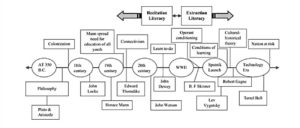
(Edgar, D, 2012, p. 5)
Barbour, M & Labonte, R. (2018) An Overview of eLearning Organizations and Practices in Canada. In R. Ferdig & K. Kennedy (Eds.), Handbook of research on K-12 online and blended learning (pp. 600-616). Pittsburgh, PA: Carnegie Mellon University ETC Press.
Bates, T. (2014). Learning Theories and Online Learning. [Blog post]. Retrieved fromhttps://www.tonybates.ca/2014/07/29/learning-theories -and-online-learning/.
Edgar, D. (2012). Learning Theories and Historical Events Affecting Instructional Design in Education: Recitation Literacy Toward Extraction Literacy Practices. SAGE Open, 2(4), 1-9, https://doi.org/10.1177/2158244012462707
Below is a voice-over video of me explaining my learnings of the annotating activity I and my group participated in. We ended up annotating all three of the readings in Topic 2: The history and context of k-12 distributed and online learning and evidence of the other two annotations can be seen in the screen captures in this blog post.
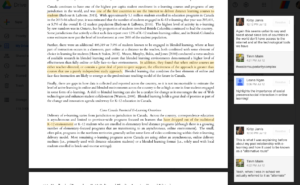
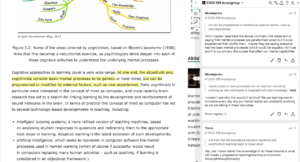
Script used for video:
For one of the optional course activities, I have chosen to do a summary and reflective video about one of the pod activities, my group and I completed. For topic 2, the history and context of k-12 distributed and online learning suggested activity; was for you and your group “meet” to compare and contrast k-12 online and open theory and history based on our course readings. On this screen, I have an example of one of our group meetings using the google chrome extension Hypothes.is. The program allowed us to annotate the reading and also reply to other member’s annotated comments. I was surprised by just how conatively engaging this exercise turned out to be. I felt more involved in the article and interested because I was able to not only record my thoughts but read other people’s views and then re-think my own. Having the opportunity to reply to other comments allowed us as individual minds to work together to answer one another’s questions, question each other’s thoughts, and understand the content to a deeper level. This activity allowed me and my group to practice our digital literacy by experiencing and learning about a program new to us all that can aid us in our future collaborations and teaching.
© 2025 Kirby's Education Journey
Theme by Anders Noren — Up ↑
Recent Comments